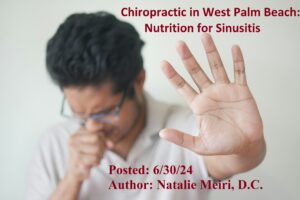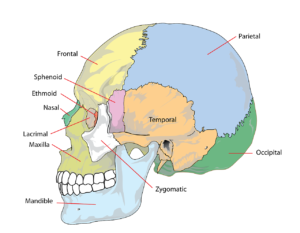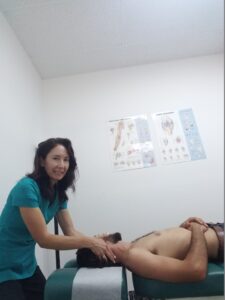
Chiropractic in West Palm Beach: Nutrition for Sinusitis is about the natural treatments and preventative recommendations available for sinusitis (sinus infection) through chiropractic and nutrition. There are higher rates of sinusitis in the South, Midwest, and among women in the U.S.A. Kids younger than 15 years of age and adults aged 25 to 64 years are affected most.
Indeed, the symptoms of sinusitis can be very painful and uncomfortable. This includes fever (usually low-grade, but higher in some cases), cough, headache, earache, toothache, facial pain, cranial pressure, difficulty breathing through the nose, loss of the sense of smell, fatigue, malaise, halatosis and facial pain. Furthermore, it can even cause facial swelling along with a stuffy nose and thick discharge of mucus. Next, the postnasal drip may cause a sore throat, nausea and difficulty sleeping.
Anatomy of Paranasal Sinuses
The paranasal sinuses are located near the nose and connect to your nasal cavity. There are four paranasal sinuses: maxillary, ethmoid, sphenoid, and frontal. They are named corresponding to the respective bone from which it takes its name. The sinuses are hollow spaces in the skull and facial bones around the nose. These are air-filled cavities within the frontal, ethmoidal, sphenoidal, and maxillary bones. All drain into the superior (upper) or lateral (side) aspect of the nose. The sinuses’ lining the mucosa (mucus membrane) is continuous with the nasal cavity. Therefore, any infections from the nasal mucosa can easily spread to the sinuses.
Cause of Sinusitis
The cause of Sinusitis is multifactorial. Most people with colds have an element of viral sinusitis. If you have atopy, a genetic immune system problem that makes you more likely to develop allergic diseases (e.g. seasonal allergies), you are more susceptible to sinusitis. So sinusitis can be caused by allergens, environmental irritants, viruses, fungi, and bacteria. For example, irritants are animal dander, polluted air, smoke, and dust.
First, a viral upper respiratory infection may cause sinusitis secondary to edema. Second, inflammation of the nasal lining and the production of thick mucus that obstructs the paranasal (near to nose) sinuses allows a secondary bacterial overgrowth. Third, allergic rhinitis (hayfever) can lead to sinusitis.
Other risk factors of sinusitis include:
- Air travel can lead to inflammation of the sinuses, because of changes in air pressure.
- Chronic sinusitis may be caused by small growths in the nose, injury of the nasal bones, air pollution, dental complications, emotional stress, smoking, and exposure to irritant fumes and smells.
- Allergic sinusitis may be caused by hay fever or food allergies, especially allergies to milk/ dairy products.
- People with compromised immune systems (e.g. HIV) are more susceptible to sinusitis

Helpful Supplementation for Sinusitis
Acidophilus – to replace the necessary bacteria in intestines
Bee Pollen– helps with healing
Flaxseed oil– reduces inflammation
Multivitamin and mineral complex– to enhance proper nutrition
Quercetin – an antioxidant, increases immunity and decreases reaction to allergens
Calcium and Magnesium – Helps with stress.
Multienzyme complex– improves digestion
Raw thymus glandular– for immune function protection
Coenzyme Q10– helps immune system
Colloidal silver– acts as a natural antibiotic
Dimethylsulfoxide (DMSO)– helps with pain relief
Garlic– stimulates immune response
Methylsulfonyl-methane (MSM)– provides some pain relief and reduces inflammation
Proteolytic enzymes– aids in destruction of free radicals
Pycnogenol or grape seed extract- Powerful antioxidants that reduce inflammation and the frequency of colds and flu. Also helps neutralize allergic reactions.
Sea mussel– contributes to needed amino acids and aids in the functioning of the mucous membranes.
Zinc lozenges– acts as antiviral and immune system booster
Vitamins:
A with mixed carotenoids – (check with your doctor if pregnant)- are antioxidants helpful against allergens, enhances immune response
B complex –nerve function optimization.
B5 (pantothenic acid) and vitamin B6(pyridoxine) and vitamin B12– Aids in the formation of antibodies and therefore helps immune system function.
C with bioflavonoids– helps immune function, in preventing infection and decreasing mucus.
E– speeds healing
Herbs- Anise, fenugreek, marshmallow, and red clover help to loosen phlegm and remove congestion. Bayberry is a decongestant and astringent. Goldenseal, Echinacea helps the immune system and fights viral infection. Mullein decreases inflammation and soothes irritation. Nettle is good for all types of allergies and respiratory problems. Olive leaf extract has both antibacterial and anti-inflammatory properties.
Natural lifestyle/diet recommendations
Firstly, drink plenty of water and fresh vegetable/ fruit juices. Secondly, consume plenty of hot liquids such as soups and herbal teas. These help the mucus to flow, relieving congestion and sinus pressure. Secondly, adding cayenne pepper, garlic, ginger, and raw onion to soups or teas may bring even faster relief. Thirdly, eliminate sugar from your diet. Fourthly, reduce your salt intake. Fifthly, limit or omit dairy foods, except for low-fat soured products like yogurt and cottage cheese. Dairy products increase mucus formation. Lastly, mix a solution of 1 cup warm water, 1 teaspoon of sea salt, and a pinch of bicarbonate of soda. Use a squeeze spray bottle or an eyedropper to instill the solution in the nostrils, one side at a time. Repeat this procedure three or four times a day as necessary for relief from stuffiness. This rinses debris or mucus from the nasal cavity.
Chiropractic Care For Sinusitis
In conjunction with chiropractic adjustments, soft tissue techniques may provide significant relief for sinusitis.
Acupressure is a method of manual point pressure applied to acupuncture points for producing analgesia (insensibility to pain). One method of treatment is by manual (by hand/finger) pressure. In theory, blockage or other dysfunction in the meridian causes illness.
Chapman (Neurolymphatic) Reflexes
Chapman reflex points are found in the deep fascia and are associated with specific viscera (organs). These reflex points can be used as a diagnostic aid (diagnosis of illness) to locate a pathologic (indicative of disease) change. Also, these reflexes influence visceral function through nervous system input. Finally, these reflexes are useful for influencing the motion of fluids, mostly lymph. And for influencing visceral function through the nervous system.
Cranial Manipulation– Cranial Manipulation to the face and skull is a very gentle technique designed to improve the movement of the bones of your head. It reduces pressure in the head/face.

Your chiropractor in West Palm Beach will adjust you to improve the relationship between the spine and nervous system, which affects the function of all the organs and systems in your body. She will educate you on how to prevent future suffering by learning and implementing a lifestyle for health self enhancement. In this regard, we may give take home exercises, recommend ergonomic changes and nutritional/lifestyle changes. Call Dr. Natalie Meiri, your chiropractor in West Palm Beach at 561-253-8984 to find out more about Chiropractic in West Palm Beach: Nutrition for Sinusitis or to schedule an appointment.
References:
Prescription for Nutritional Healing (3rd edition), Phyllis A. Balch, CNC
Thomas Souza, (2018) Differential Diagnosis and Management for the Chiropractor
*For all the above, please check with your primary care doctor before implementation of supplement recommendations.